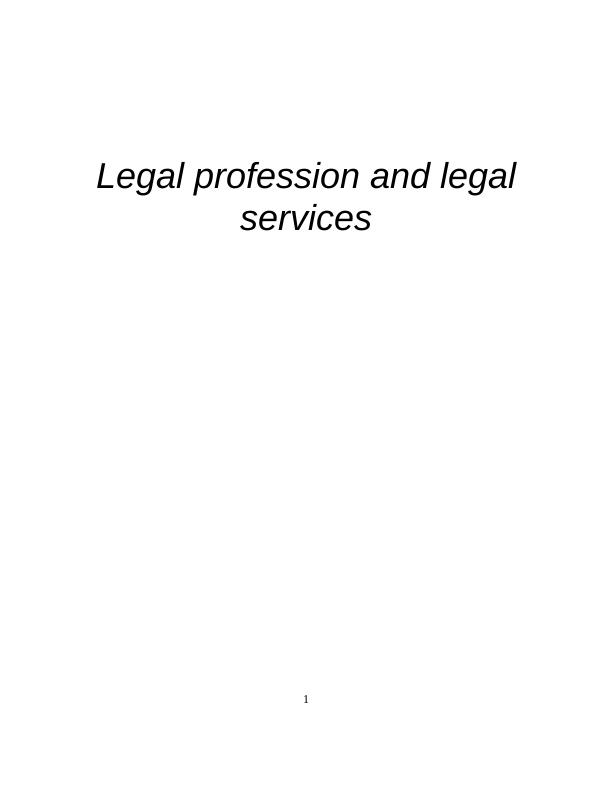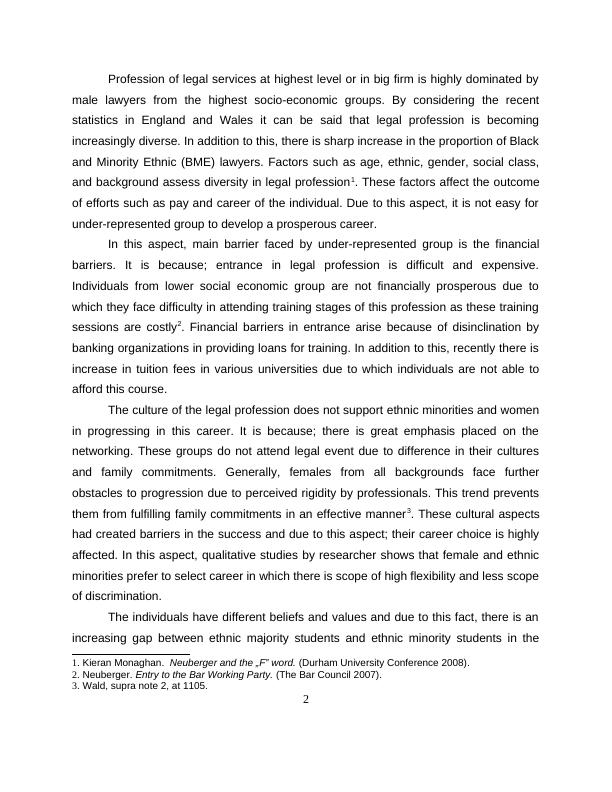Legal Profession and Legal Services
8 Pages2558 Words28 Views
Added on 2019-12-03
Legal Profession and Legal Services
Added on 2019-12-03
ShareRelated Documents
Legal profession and legal
services
1
services
1

Profession of legal services at highest level or in big firm is highly dominated by
male lawyers from the highest socio-economic groups. By considering the recent
statistics in England and Wales it can be said that legal profession is becoming
increasingly diverse. In addition to this, there is sharp increase in the proportion of Black
and Minority Ethnic (BME) lawyers. Factors such as age, ethnic, gender, social class,
and background assess diversity in legal profession1. These factors affect the outcome
of efforts such as pay and career of the individual. Due to this aspect, it is not easy for
under-represented group to develop a prosperous career.
In this aspect, main barrier faced by under-represented group is the financial
barriers. It is because; entrance in legal profession is difficult and expensive.
Individuals from lower social economic group are not financially prosperous due to
which they face difficulty in attending training stages of this profession as these training
sessions are costly2. Financial barriers in entrance arise because of disinclination by
banking organizations in providing loans for training. In addition to this, recently there is
increase in tuition fees in various universities due to which individuals are not able to
afford this course.
The culture of the legal profession does not support ethnic minorities and women
in progressing in this career. It is because; there is great emphasis placed on the
networking. These groups do not attend legal event due to difference in their cultures
and family commitments. Generally, females from all backgrounds face further
obstacles to progression due to perceived rigidity by professionals. This trend prevents
them from fulfilling family commitments in an effective manner3. These cultural aspects
had created barriers in the success and due to this aspect; their career choice is highly
affected. In this aspect, qualitative studies by researcher shows that female and ethnic
minorities prefer to select career in which there is scope of high flexibility and less scope
of discrimination.
The individuals have different beliefs and values and due to this fact, there is an
increasing gap between ethnic majority students and ethnic minority students in the
1. Kieran Monaghan. Neuberger and the „F‟ word. (Durham University Conference 2008).
2. Neuberger. Entry to the Bar Working Party. (The Bar Council 2007).
3. Wald, supra note 2, at 1105.
2
male lawyers from the highest socio-economic groups. By considering the recent
statistics in England and Wales it can be said that legal profession is becoming
increasingly diverse. In addition to this, there is sharp increase in the proportion of Black
and Minority Ethnic (BME) lawyers. Factors such as age, ethnic, gender, social class,
and background assess diversity in legal profession1. These factors affect the outcome
of efforts such as pay and career of the individual. Due to this aspect, it is not easy for
under-represented group to develop a prosperous career.
In this aspect, main barrier faced by under-represented group is the financial
barriers. It is because; entrance in legal profession is difficult and expensive.
Individuals from lower social economic group are not financially prosperous due to
which they face difficulty in attending training stages of this profession as these training
sessions are costly2. Financial barriers in entrance arise because of disinclination by
banking organizations in providing loans for training. In addition to this, recently there is
increase in tuition fees in various universities due to which individuals are not able to
afford this course.
The culture of the legal profession does not support ethnic minorities and women
in progressing in this career. It is because; there is great emphasis placed on the
networking. These groups do not attend legal event due to difference in their cultures
and family commitments. Generally, females from all backgrounds face further
obstacles to progression due to perceived rigidity by professionals. This trend prevents
them from fulfilling family commitments in an effective manner3. These cultural aspects
had created barriers in the success and due to this aspect; their career choice is highly
affected. In this aspect, qualitative studies by researcher shows that female and ethnic
minorities prefer to select career in which there is scope of high flexibility and less scope
of discrimination.
The individuals have different beliefs and values and due to this fact, there is an
increasing gap between ethnic majority students and ethnic minority students in the
1. Kieran Monaghan. Neuberger and the „F‟ word. (Durham University Conference 2008).
2. Neuberger. Entry to the Bar Working Party. (The Bar Council 2007).
3. Wald, supra note 2, at 1105.
2

attainment of higher education degree. In addition to this, minority students have high
possibility of leaving their post-secondary education. Generally, this aspect arises
because environment does not accept ethnic minorities in this career. They have to face
racial discrimination in college campus. In various cases, teachers do not have
equivalent attitude towards these students4. Therefore, individual belong from under-
represented group does not get fair opportunity to show their potential. Further, this fact
also affects their academic reports.
Under-represented groups do not have facilities similar to individuals who belong
from high social economic class. It is because; they are not aware of the legal courses
and their admission process5. They are stuck with their traditional career opportunities.
However, students who are interested in developing their career in this field are also not
able to do so due to their poor financial position.
By considering this fact, there is in-built advantage for children from higher socio-
economic groups is that they are supplemented by links that have built them up over
time between legal firms and independent schools. In this aspect, researchers had
identified obstructions at a very early stage in the progress to the legal market.
According to the study of Rolfe and Anderson (2003) some legislation firms had
developed stronger links with selective and independent schools6. Due to this aspect,
there is difference in knowledge and skills of majority and ethnic minority group. For
such approach, one public sector organization had provided justification that selected
school was attended by their trainees. This obstacle is intelligibly applicable more to
those individuals who do not attend selective schools and are most likely to be those
from a lower class or with lower incomes.
Diversity in legal profession in England and Wales has conflicting trend. Various
law schools had made effort in order to diversify the ranks of the profession. Law is a
competitive profession for entrance regardless of their race and gender. Further,
4 . Hilary Sommerlad and et. al. The Futures of Legal Education and the Legal Profession. (Bloomsbury
Publishing. 2015).
5 . Redfield Sarah Diversity Realized: (Putting The Walk With The Talk For Diversity In The Legal
Profession, 2009)13. pp. 20–2.
6 . Heather Rolfe and Tracy Anderson. A firm choice: law firms‟ preferences in the recruitment of trainee
solicitors. (Commissioned by the Law Society 2003).
3
possibility of leaving their post-secondary education. Generally, this aspect arises
because environment does not accept ethnic minorities in this career. They have to face
racial discrimination in college campus. In various cases, teachers do not have
equivalent attitude towards these students4. Therefore, individual belong from under-
represented group does not get fair opportunity to show their potential. Further, this fact
also affects their academic reports.
Under-represented groups do not have facilities similar to individuals who belong
from high social economic class. It is because; they are not aware of the legal courses
and their admission process5. They are stuck with their traditional career opportunities.
However, students who are interested in developing their career in this field are also not
able to do so due to their poor financial position.
By considering this fact, there is in-built advantage for children from higher socio-
economic groups is that they are supplemented by links that have built them up over
time between legal firms and independent schools. In this aspect, researchers had
identified obstructions at a very early stage in the progress to the legal market.
According to the study of Rolfe and Anderson (2003) some legislation firms had
developed stronger links with selective and independent schools6. Due to this aspect,
there is difference in knowledge and skills of majority and ethnic minority group. For
such approach, one public sector organization had provided justification that selected
school was attended by their trainees. This obstacle is intelligibly applicable more to
those individuals who do not attend selective schools and are most likely to be those
from a lower class or with lower incomes.
Diversity in legal profession in England and Wales has conflicting trend. Various
law schools had made effort in order to diversify the ranks of the profession. Law is a
competitive profession for entrance regardless of their race and gender. Further,
4 . Hilary Sommerlad and et. al. The Futures of Legal Education and the Legal Profession. (Bloomsbury
Publishing. 2015).
5 . Redfield Sarah Diversity Realized: (Putting The Walk With The Talk For Diversity In The Legal
Profession, 2009)13. pp. 20–2.
6 . Heather Rolfe and Tracy Anderson. A firm choice: law firms‟ preferences in the recruitment of trainee
solicitors. (Commissioned by the Law Society 2003).
3

End of preview
Want to access all the pages? Upload your documents or become a member.
